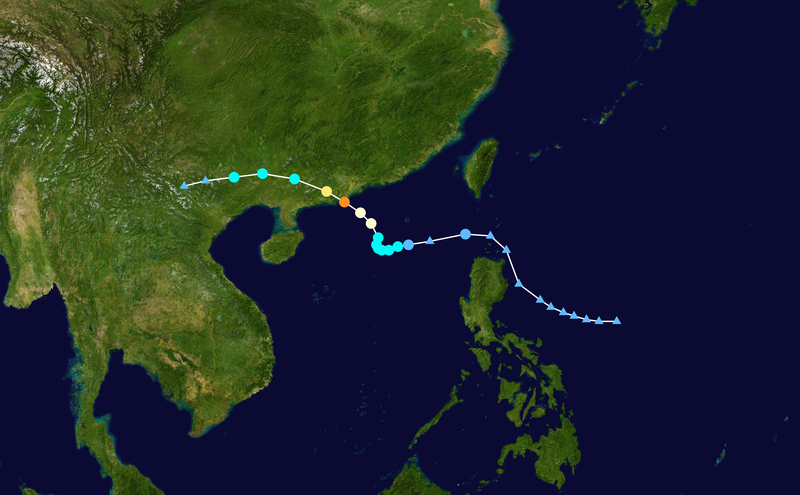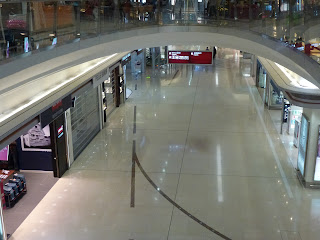I have no pictures, as I left my SD card in this laptop I am currently typing on. I will be going to the Peak again sometime, though, so stay tuned for some stereotypical shots of the most photographed skyline in the world!
On Monday, I awoke to a Typhoon Signal no. 3:
Now, if you're confused by this system ("what's that upside-down T??"), don't worry. Everyone is at first. The Hong Kong Observatory's system of "Signals" grew out of the 19th and early-20th century need for meteorological authorities to warn mariners of impending storms. The original system had 10 signals, each with a flashing light sequence and a physical sign, an upside-down T being the one for Signal no. 3. Here's what they each mean:
Signal no. 1 - "standby": a tropical depression or storm is within 800 km of Hong Kong and may affect the area.
Signal no. 3 - "strong winds": strong winds (sustained 41-62 km/h, gusts >110 km/h) are expected or blowing.
Signal no. 8 - "gale-force winds": sustained winds 63-117 km/h, gusts >180 km/h are expected or blowing.
Originally, there were four signals 5-8 which indicated which direction the winds were blowing from, so that ships would know where to drop anchor to achieve the greatest shelter. In the 1960's, as the system increasingly became used for civilian purposes, they were all collapsed into "8" to reduce confusion about the severity of the system.
In Hong Kong law, all public offices and most businesses will close after a Signal no. 8 is hoisted ("hoisting" coming from the old practice of actually hoisting physical signals). For the first hour or so after, public transit will run at rush-hour or near rush-hour intervals to facilitate people getting home. Then most transit operations will cease.
Signals 9 and 10 indicate increasingly destructive forces. the Signal 10 in particular is exceedingly rare, due to the rather sheltered location of Hong Kong, occurring on average once every 5 years. (To give a comparison, the lower end of Signal 10s are roughly equivalent to Category 3 Hurricanes, which hit the Southern United States multiple times every hurricane season).
In these "strong winds", we decided to go to a popular cha chaan teng (茶餐廳, HK-style diner) in Tsuen Wan, as there would be no line ups!
Gala Café is known for its egg dishes, such as this "small" ham omelette:
And this regular sized egg and beef sandwich:
The taste isn't bad, but the real draw is the massive portions. Demand is so high for these things that they've stopped selling all egg sandwiches on the weekends (when the crowds come) to focus on their omelettes.
They're also known for their Ovaltine milkshake, vaguely reminiscent of the malt milkshakes so popular at 50's-style diners.
My dad's flight would be arriving at 7, so we went home and chilled for a bit.
However, we were about to leave Sham Tseng when this happened, at 5:40:
Now, on Sunday I had not expected this signal to ever be raised, because the typhoon in question, Vicente, was heading on a smooth westbound trajectory away from Hong Kong. But then this happened on Monday:

It literally did a 90-degree turn and was headed straight for us.
We waited about 30 minutes for the minibus to take us to Tsing Yi Airport Express Station:
And here are some photos of that ride:
 |
| Look familiar? I took the same shot a couple of days ago! |
We hopped on the train, a premium service operated separately from the rest of the MTR and designed like an aircraft cabin:
And took the 20 minute ride into Hong Kong International Airport.
 |
| Oh, this place is called Sunny Bay. Apt, no? |
 |
| Passing through the New Town of Tung Chung (東涌) |
 |
| Still pouring rain outside! |
After we picked him up, we ate at Chao Inn, a Chiu Chow (潮州, pinyin Chaozhou) style restaurant.
 |
| The view from the table |
An appetizer of various meats marinated in master stock (鹵水), a preparation which is traditionally repeatedly used to marinate or poach, hence the name. The meat on the top is goose, with pig ears, sausage, and various other meats and entrails below.
It was followed by a dish of stir-fried chicken, a meat which I think was scallop, and hairy cucumber (節瓜).
A soup was next:
Looks like shark's fin, smells like shark's fin, tastes like shark's fin, but... isn't. This soup consists of all the ingredients in shark's fin soup (魚翅) - dried scallop (瑤柱), chicken, and a soy-sauce based preparation known as "red cooking sauce" (紅燒) - except for the fins themselves. Instead, fish maw (花膠) was substituted.
Deep fried crab sticks - quite a bit of a disappointment, since the menu said crab meat...
Stir-fried grouper (石斑魚) and potatoes (the menu has 土豆, lit. earth-bean, a somewhat poetic name)
The star of the dinner was of course, the abalone (鮑魚):
While I had fresh abalone in that seafood dinner a week and a bit ago, even then I had noted that the dried variety (乾鮑) was prized for its complex taste profile - it's quite hard to describe unless you've had it or other Chinese dried seafood dishes, but it's always delicious.
Chicken, marinated and braised in some plum sauce:
and a light vegetable dish to round out the dinner:
with a final carbohydrate burst in the form of stir-fried yi mein (乾燒伊麵).
Dessert was lai wong bao (奶黃包), a bun filled with a custard made from milk and salted duck egg yolk:
Yep, only the Chinese could make a dessert out of salted duck eggs.
We had a friend drive us back home (the same one who took me hiking last Sunday!)
 |
| You can see my house from here! |
 |
| The Ting Kau bridge was closed due to high winds, |
 |
| So we detoured through Tsuen Wan. |
Overnight, the winds picked up even more, and a Signal 9 and eventually Signal 10 were hoisted, the first time in 13 years that a 10 had been issued. It had turned into the equivalent of a Category 4 Hurricane by the time it made landfall in Taishan (台山), Guangdong.
Here's some of the damage the day after:
Those trees were upright yesterday!






































No comments:
Post a Comment